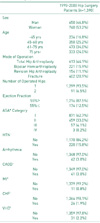1. Mahomed NN, Barrett JA, Katz JN, et al. Rates and outcomes of primary and revision total hip replacement in the United States medicare population. J Bone Joint Surg Am. 2003. 85-A:27–32.

2. Barrett J, Losina E, Baron JA, Mahomed NN, Wright J, Katz JN. Survival following total hip replacement. J Bone Joint Surg Am. 2005. 87:1965–1971.

3. Bhattacharyya T, Iorio R, Healy WL. Rate of and risk factors for acute inpatient mortality after orthopaedic surgery. J Bone Joint Surg Am. 2002. 84-A:562–572.

4. Katz JN, Barrett J, Mahomed NN, Baron JA, Wright RJ, Losina E. Association between hospital and surgeon procedure volume and the outcomes of total knee replacement. J Bone Joint Surg Am. 2004. 86-A:1909–1916.

5. Kahn RL, Hargett MJ, Urquhart B, Sharrock NE, Peterson MG. Supraventricular tachyarrhythmias during total joint arthroplasty. Incidence and risk. Clin Orthop Relat Res. 1993. (296):265–269.
6. Polanczyk CA, Goldman L, Marcantonio ER, Orav EJ, Lee TH. Supraventricular arrhythmia in patients having noncardiac surgery: clinical correlates and effect on length of stay. Ann Intern Med. 1998. 129:279–285.

7. Christians KK, Wu B, Quebbeman EJ, Brasel KJ. Postoperative atrial fibrillation in noncardiothoracic surgical patients. Am J Surg. 2001. 182:713–715.

8. Nazon D, Abergel G, Hatem CM. Critical care in orthopedic and spine surgery. Crit Care Clin. 2003. 19:33–53.

9. Agency for Healthcare Research and Quality. Patient and hospital characteristics for CCS principal procedure category: arthroplasty of knee (surgical reconstruction or replacement of knee), hip replacement, total and partial. Healthcare cost and utilization project. Avalilable from:
http://hcupnet.ahrq.gov/.
10. David E, Longnecker FL, Murphy LD. Introduction to anesthesia. 1997. 9th ed. Philadelphia: WB Saunders;18–19.
11. White BL, Fisher WD, Laurin CA. Rate of mortality for elderly patients after fracture of the hip in the 1980's. J Bone Joint Surg Am. 1987. 69:1335–1340.

12. Kenzora JE, McCarthy RE, Lowell JD, Sledge CB. Hip fracture mortality. Relation to age, treatment, preoperative illness, time of surgery, and complications. Clin Orthop Relat Res. 1984. (186):45–56.
13. Kho DH, Kim KH, Shin JY, Lee JH, Kim DH. Postoperative mortality rate of hip fracture in elderly patients. J Korean Fract Soc. 2006. 19:117–121.

14. Eiskjaer S, Ostgård SE. Risk factors influencing mortality after bipolar hemiarthroplasty in the treatment of fracture of the femoral neck. Clin Orthop Relat Res. 1991. (270):295–300.

15. Kalra S, McBryde CW, Lawrence T. Intracapsular hip fractures in end-stage renal failure. Injury. 2006. 37:175–184.

16. Bae IT, Lee WS, Kim SB, Heo YM, Park CY. Postoperative complications of hip fractures in patients with chronic kidney disease. J Korean Hip Soc. 2009. 21:169–173.

17. Mantilla CB, Horlocker TT, Schroeder DR, Berry DJ, Brown DL. Frequency of myocardial infarction, pulmonary embolism, deep venous thrombosis, and death following primary hip or knee arthroplasty. Anesthesiology. 2002. 96:1140–1146.

18. Basilico FC, Sweeney G, Losina E, et al. Risk factors for cardiovascular complications following total joint replacement surgery. Arthritis Rheum. 2008. 58:1915–1920.

19. Wolf LD, Hozack WJ, Rothman RH. Pulmonary embolism in total joint arthroplasty. Clin Orthop Relat Res. 1993. (288):219–233.

20. Wroblewski BM, Siney PD, White R. Fatal pulmonary embolism after total hip arthroplasty. Seasonal variation. Clin Orthop Relat Res. 1992. (276):222–224.
21. Ceder L, Thorngren KG, Wallden B. Prognostic indicators and early home rehabilitation in elderly patients with hip fractures. Clin Orthop Relat Res. 1980. (152):173–184.

22. Owens WD, Felts JA, Spitznagel EL Jr. ASA physical status classifications: a study of consistency of ratings. Anesthesiology. 1978. 49:239–243.






 PDF
PDF ePub
ePub Citation
Citation Print
Print





 XML Download
XML Download